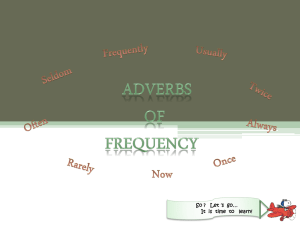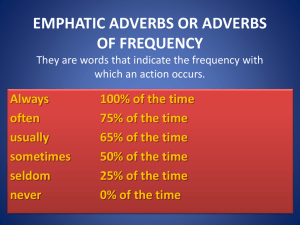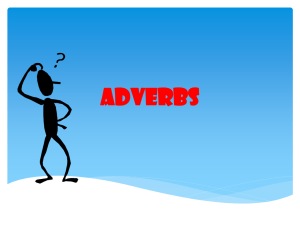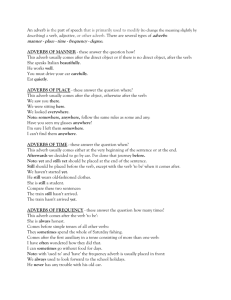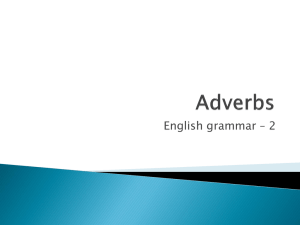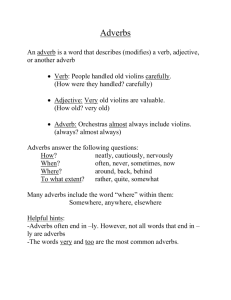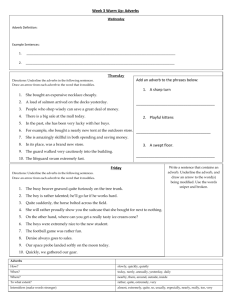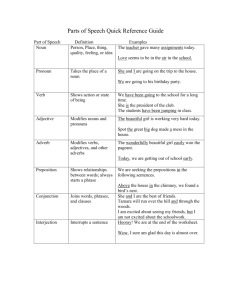CHAPTER TWENTY-THREE: ADVERBS
advertisement
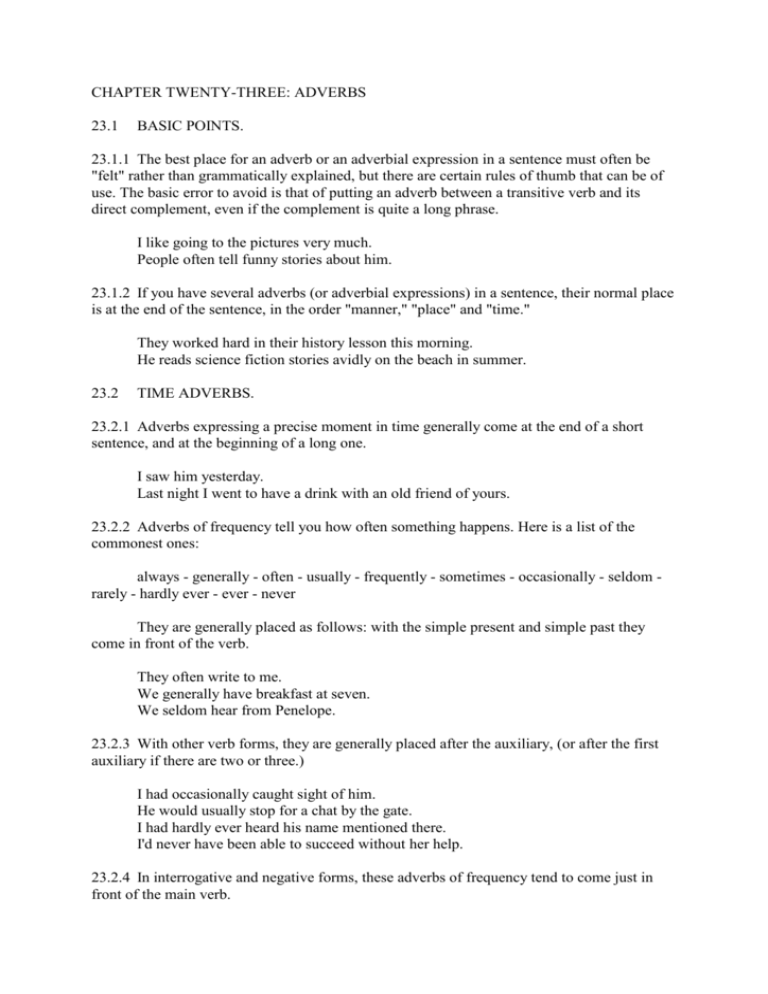
CHAPTER TWENTY-THREE: ADVERBS 23.1 BASIC POINTS. 23.1.1 The best place for an adverb or an adverbial expression in a sentence must often be "felt" rather than grammatically explained, but there are certain rules of thumb that can be of use. The basic error to avoid is that of putting an adverb between a transitive verb and its direct complement, even if the complement is quite a long phrase. I like going to the pictures very much. People often tell funny stories about him. 23.1.2 If you have several adverbs (or adverbial expressions) in a sentence, their normal place is at the end of the sentence, in the order "manner," "place" and "time." They worked hard in their history lesson this morning. He reads science fiction stories avidly on the beach in summer. 23.2 TIME ADVERBS. 23.2.1 Adverbs expressing a precise moment in time generally come at the end of a short sentence, and at the beginning of a long one. I saw him yesterday. Last night I went to have a drink with an old friend of yours. 23.2.2 Adverbs of frequency tell you how often something happens. Here is a list of the commonest ones: always - generally - often - usually - frequently - sometimes - occasionally - seldom rarely - hardly ever - ever - never They are generally placed as follows: with the simple present and simple past they come in front of the verb. They often write to me. We generally have breakfast at seven. We seldom hear from Penelope. 23.2.3 With other verb forms, they are generally placed after the auxiliary, (or after the first auxiliary if there are two or three.) I had occasionally caught sight of him. He would usually stop for a chat by the gate. I had hardly ever heard his name mentioned there. I'd never have been able to succeed without her help. 23.2.4 In interrogative and negative forms, these adverbs of frequency tend to come just in front of the main verb. Have you ever heard such a crazy story? You don't often see that kind of car nowadays. She will not always be as pleasant as she has been today. 23.2.5 The following adverbs generally occupy the same place as adverbs of frequency: almost - nearly - also - even - hardly - barely - scarcely - quite - rather - still - probably - possibly - certainly - really - actually (... and others!) They have almost finished their reading, I think. We will also be looking at some poems by Wordsworth. I hardly think it's the right time to do that, Georgina! They would probably have been hoping for more cooperation from us. If you put these adverbs earlier than their normal place, you in fact give them more importance. I certainly had never imagined that she would do a thing like that. He really will have to pull his socks up! 23.3 ADVERBS OF MANNER. 23.3.1 Firstly, as is mentioned in 23.1.1, you must avoid putting them between a transitive verb and its direct complement. In fact they are most often placed after the complement. We reached the summit easily. She paid him generously for his services. 23.3.2 If the sentence is long, an adverb of manner may be placed in the same way as an adverb of frequency, as explained in the previous paragraphs. They cleverly found the right answer to this tricky question. He had effectively put an end to all discussion of the matter. 23.3.3 With intransitive verbs, adverbs of manner usually follow the verb. She sings beautifully. They galloped quickly through the forest. 23.4 ADVERBS OF PLACE. 23.4.1 Adverbs of place generally come at the end of the sentence, (as was aleady mentioned in 23.1.2.) I've left my keys upstairs. I met her for the first time in church. 23.4.2 An adverb expressing movement will usually come in front of an adverb expressing position. The children are running around outside. She went to university in the States. 23.4.3 If your verb expresses movement, it is naturally logical to put the adverb expressing movement immediately after it, (even if this may contradict the idea first given in 23.1.2.) They ran outside in a great hurry. She walked away quite deliberately. 23.5 OTHER CONSIDERATIONS. 23.5.1 If you have two adverbs of the same type, the more particular will come before the more general. She died at seven o'clock on a Saturday morning in July 1934. He's studying at a Technical College in London. 23.5.2 If you have a short adverb and a longer adverbial expression together, you will generally put the shorter form first. Speak clearly and as slowly as you can, please. They worked quite hard and with extreme dedication. 23.5.3 "Enough" comes after an adjective, but in front of a noun. She isn't clever enough to do it on her own. Haven't you had enough time for those exercises yet? 23.5.4 "Even" and "only" usually precede the word that they qualify. Only Peter drank the tea - (no-one else wanted any.) Peter only drank the tea - (someone else made it.) Peter drank only the tea - (he didn't touch the whisky!) Even Jennifer was punished - (absolutely everybody was!) Jennifer was even punished - (she wasn't just shouted at.) 23.5.5 Certain adverbs cause the inversion of verb and subject when they come at the beginning of the sentence. Look at the following examples: No sooner were they there than the festivities started. Never would I have guessed how much she loved me. Hardly had they left the house when it began to pour. Only twice did he try to do business with us. In fact this is rather old-fashioned in style, and is thus perhaps not to be imitated. 23.5.6 An adverb which is used to qualify an adjective, a preposition or another adverb is (quite naturally) placed in front of the word it qualifies. We are particularly anxious to see them. The book was exactly in the middle of the table. They worked incredibly hard for that test. 23.5.7 Although "almost" and "nearly" are basically synonyms, it is worth remembering that "nearly" can really only be applied to down-to-earth ideas of space or time, or where things can be compared and progress can be measured. It's almost six o'clock - It's nearly six o'clock. We've almost a mile to go - We've nearly a mile to go. I almost decided to stay - I nearly decided to stay. Your drawing's almost as good as mine - ... is nearly as good ... When it's a question of the notion of "degree," we would normally use "almost." What you say is almost unbelievable. In favourable lighting she can look almost beautiful. 23.5.8 There is often a certain amount of confusion in students' minds over "yet" and "still." The following explanations should help to sort it out for you. "Yet" means "up to the time of speaking;" it is principally used in negatives and interrogatives, and generally comes at the end of the sentence. He hasn't finished yet. Have you got their answer yet? He left at six and hasn't come back yet. They aren't here yet; shall we wait for them? Aren't you ready yet? Note the difference between "yet" and "already;" the latter means "on some occasion in the past," or indicates that an action has (just) finished. I have already met your father. You haven't eaten all those chips already, have you? "Still" insists on the idea of an action or a state of affairs continuing, and normally comes immediately after the subject, except with the verb "to be." She still loves me after all these years. He's still in his bath. You still have to revise your chemistry, you know! Do you still believe in Father Christmas? Have you still got that old Everly Brothers record? In a negative, (indicating that something is "continuing not to happen,") "still" also immediately follows the subject. They still haven't accepted our offer. Henry still doesn't think that's a very good idea. She still isn't very convinced of my trustworthiness. Note the difference between "still" and "always;" the latter means "all the time" or "every time." Why do you always laugh at your little sister? That child is always talking during lessons ... and he's still talking now!
